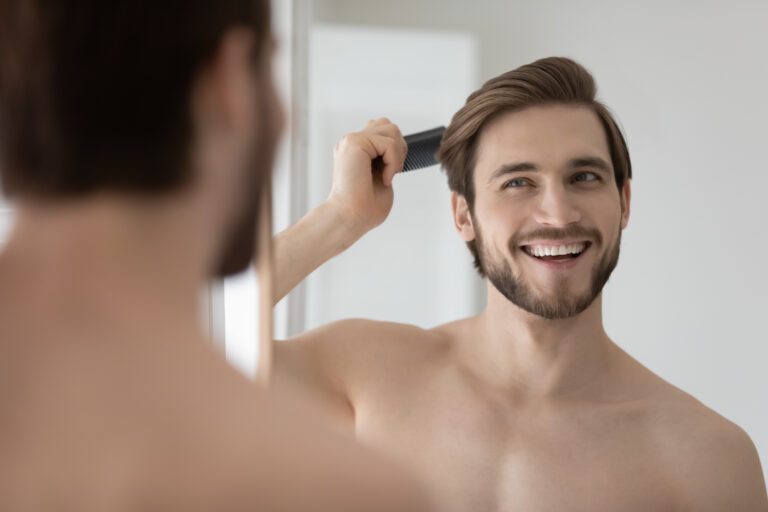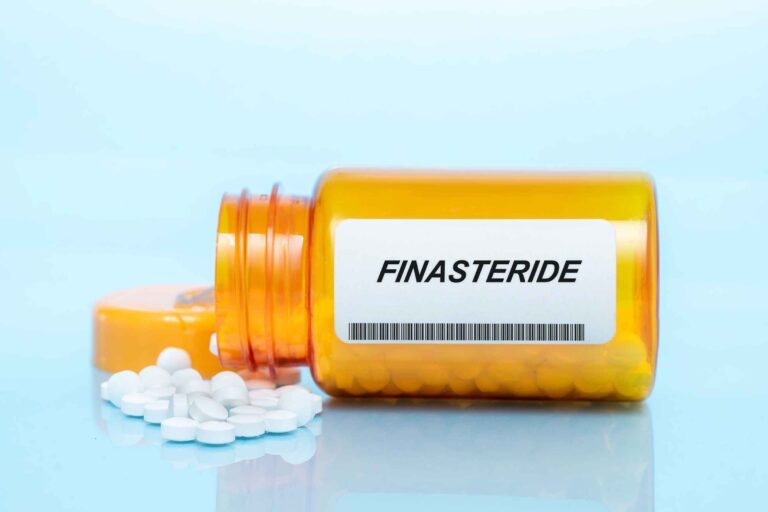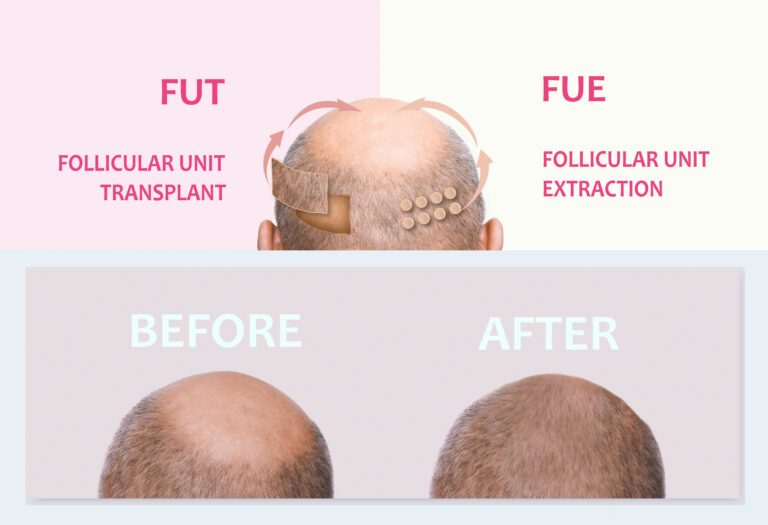How to Reduce Side Effects of Finasteride with Smaller Dosages
Finasteride is a miracle treatment for male pattern hair loss. It’s the 90th most prescribed drug for a reason. Instead of stimulating hair growth at a superficial level, finasteride completely stops hair loss.
The drug exerts its action by inhibiting DHT, the main culprit behind hair loss. Naturally, however, altering the male hormone levels might result in several unpleasant side effects.
For this reason, many dermatologists have persistently tried to reduce the side effects of finasteride by using smaller dosages. Luckily, the treatment proved to be almost as efficient at low doses too!
Do you want to find out more? In today’s article, we’ll explain everything you need to know about the best finasteride dosage for hair loss, and how to reduce the drug’s adverse effects. Let’s dive in!
What’s the Best Finasteride Dosage for Reduced Side Effects?
To reduce the side effects of any long-term medication, the steady-state concentration of the drug needs to drop. In other words, you need to lower the amount of drug present at all times in your blood.
If the drug’s levels decrease, so will its adverse effects and efficacy. For this reason, you want the dose of finasteride to be low enough that the side effects aren’t as uncomfortable while still being high enough to exert its action.
Typically, the recommended dose of finasteride for hair loss is 1 mg daily. Yet, the drug is potent at 0.5 mg and 0.25 mg too, but with milder side effects.
It’s important to understand that experiencing undesirable effects after taking finasteride for a long time is inevitable. After all, the drug doesn’t reduce hair loss directly. Instead, finasteride alters the male hormone responsible for androgenic alopecia.
If you’re unsure about the correct dose of finasteride for you, consult your dermatologist or healthcare provider.
How Finasteride Works
Before attempting to reduce the finasteride dose, you should understand how it works.
Finasteride is one of the best treatments for hair loss. While the drug’s first indication was benign prostatic hyperplasia, the FDA also approved its use as an oral hair loss treatment in 2011.
Additionally, this drug is anti-androgenic. Specifically, it’s a 5 alpha-reductase inhibitor. To elaborate, it blocks the enzyme necessary for the production of dihydrotestosterone.
Dihydrotestosterone (DHT) is responsible for thinning out the hair and shrinking hair follicles. Yet, DHT also plays a crucial role within the male sex organ. Its functions include spermatogenesis, fertility, and increased sex drive.
So, when you take finasteride, you might experience some irritating side effects. However, these adverse effects are less common, especially since the dose of finasteride for hair loss is typically low.
The side effects include the following:
- Depression
- Mood swings
- Impaired sex drive
- Erectile dysfunction
- Gynecomastia
How to Reduce Side Effects of Finasteride with Lower Dose
Luckily, finasteride can still improve male pattern alopecia at low doses. That’s why you can reduce the side effects by taking less of the medication.
There are two ways you can do this, though. For starters, you can take low-dose finasteride instead of your usual dosage. Otherwise, you might take the drug less often!
Reducing the Dosage of Finasteride
Many people think that the higher the dose of the drug, the more effective it’ll be. That’s not the case for finasteride, though!
1 mg of finasteride every day is sufficient to treat male pattern hair loss. Most men showed the same response levels to higher doses. In fact, even 0.01 mg of finasteride showed beneficial results in treating hair loss.
Studies suggest that hair follicles’ responsiveness to 0.2 to 1 mg of finasteride is incredibly similar. However, the reason 1 mg finasteride is the most widely acceptable dose is that more men had improved results using it than the number of men that used lower doses of the drug.
So, lowering the finasteride dose might be a perfect solution to alleviate its uncomfortable effects.
0.5 mg Finasteride vs 1 mg Finasteride
There’s strong evidence that 0.5 mg finasteride has almost identical results to 1 mg finasteride.
Patients taking 0.5 mg of finasteride experienced a reduction in DHT scalp levels by about 61%. On the other hand, DHT levels in patients taking 1 mg of finasteride daily decreased by 64%.
As for the serum levels of DHT, 0.5 mg of finasteride can be about 90% as effective as 1 mg of the drug.
Simply put, the difference in scalp responsiveness to 0.5 mg vs 1 mg of finasteride is negligible. However, the blood levels indicate a significant reduction in the side effects.
For these reasons, many consider 0.5 mg as the best option for smaller finasteride doses. Doses lower than 0.5 mg can still be effective, but the numbers may drop slightly.
Extending the Dosing Interval
Extending the dosing interval of a drug simply means taking it less often. To elaborate, instead of taking 0.5 mg of finasteride daily, you can take 1 mg every other day.
You might think that you need to take finasteride every day for the best results. However, this method is just as effective as lowering the finasteride dose.
As we mentioned before, extremely low concentrations of finasteride can significantly improve male pattern alopecia while reducing the side effects. Accordingly, extending the dosing interval might work just as well.
Having said that, finasteride has an extremely short half-life of about six hours. Your body eliminates the drug in only 27 to 33 hours. So, further research is required to back up this method.
Why You Should Take Low-Dose Finasteride
There are actually numerous reasons why taking low-dose finasteride might be beneficial—other than the reduced side effects.
Usually, after five years of treatment, you’ll need to increase the finasteride dosage to notice its action.
Over time, many men would need to take up to 5 mg of finasteride. Naturally, the side effects will become more prominent.
So, starting with the lower 0.25 mg finasteride means you’ll be able to titrate the drug without a significant increase in side effects.
Furthermore, high-dose finasteride has been associated with an increased risk of prostate cancer. While finasteride isn’t carcinogenic, it masks the symptoms of the disease, making it harder to detect and treat.
To simplify, the drug won’t cause cancer, but it makes it hard to know if you have it. While this is a rare case, it can still happen.
Is Topical Finasteride a Better Alternative?
Topical finasteride is growing in popularity since it has almost no adverse effects. The drug isn’t absorbed systemically. Alternatively, it acts directly on the hair follicle.
This means most side effects of finasteride won’t just reduce, but they’ll disappear completely.
You might think the topical treatment would be less effective, but studies show that it’s highly similar to oral finasteride.
Nevertheless, topical finasteride can still have a systemic effect. The reason is that minimal amounts of the drug might be absorbed from the scalp.
Moreover, finasteride, with as little concentration as 0.2 mg, will significantly reduce DHT levels in the blood, leading to uncomfortable adverse effects.
So, it’s still unclear whether topical finasteride is potent as it acts directly on the scalp or because it’s absorbed into the system.
Like the systemic drug, you’ll need to use topical finasteride daily to notice a difference.
Stopping Finasteride
If you find the side effects intolerable, even at low finasteride doses, you should consult your dermatologist. Then, your dermatologist might advise you to come off finasteride.
Stopping finasteride will halt all its effects, including the growth of new hair. Not only that, but any hair that might have regrown will also fall off within six to twelve months. Naturally, this can be quite discouraging.
Moreover, you should never abruptly quit finasteride. If you suddenly stop taking the drug, the side effects will become more prominent, particularly mood changes.
That’s because your body will have gotten used to the adjusted DHT levels. So, a sudden spike in DHT can completely throw your body off balance.
Your dermatologist will most likely advise you to taper off the medication. This means you’ll slowly reduce its dosage until your body no longer needs the drug. You can either do this by taking low-dose finasteride or by taking it at longer intervals.
Start by taking finasteride every other day instead of daily. Then, switch to taking finasteride every 3 days. Eventually, you’ll safely stop the medication.
Post-Finasteride Syndrome
Many men report suffering from post-finasteride syndrome when stopping the drug after taking it long term. Though, the medical community doesn’t recognize the syndrome.
Some patients who took finasteride for a prolonged time claim to have suffered from the following permanent adverse reactions:
- Erectile dysfunction
- Reduction in penis size
- Reduced sensation in the penis
- Abnormal curvature and penis shape
- Gynecomastia
- Muscle atrophy
- Cognitive impairment
Frequently Asked Questions
What’s the best finasteride dosage for hair loss?
Taking as little as 0.01 mg of finasteride will significantly improve hair growth. Though, the agreed-upon and best finasteride dosage for hair loss is 1 mg.
This dose can produce unpleasant side effects. Since low-dose finasteride can be just as effective, your doctor might prescribe a lower dose at first.
Simply put, the best finasteride dosage for hair loss depends on your scalp’s responsiveness to the treatment.
Many dermatologists recommend starting with 0.25 mg finasteride, as it’s almost as potent as 1 mg finasteride, but with fewer adverse effects.
Can I reduce the side effects of finasteride without lowering the dose?
There are some methods you can try to somewhat control the side effects of finasteride.
To start, you could regularly monitor your serum DHT levels. This way, you’ll be able to tell if the unpleasant effects you’re experiencing are a result of using finasteride. You’ll also know the exact DHT levels that cause the side effects.
You should avoid using finasteride with other drugs that alter DHT levels, such as creatine or quercetin.
How can I get the best results when switching to low doses of finasteride?
While low-dose finasteride can have the same effect as 1 mg finasteride, decreasing the dose suddenly might result in losing all the progress you made.
For this reason, you should always titrate the dose. Additionally, you might want to use other hair growth methods, such as the following:
- Using topical minoxidil spray
- Switching to hair growth shampoo
- Taking hair growth supplements
- Scalp micro-needling treatments
- Scalp massages
Is the hair growth caused by finasteride worth the side effects?
Finasteride affects everybody differently. Some men might experience severe side effects, while others will feel completely normal.
What most people fear when taking finasteride is that it might lead to irreversible erectile dysfunction. However, this is extremely rare, and many medical practitioners don’t recognize it as a possibility.
Most commonly, the medication can cause decreased libido and short-term erectile dysfunction. These side effects may or may not be tolerable depending on the individual.
It’s important to understand that you should always consult your doctor when taking finasteride. Additionally, immediately report any adverse effects you might experience to your doctor.
To Conclude
Finasteride is an ideal treatment for hair loss. Typically, the recommended dose of finasteride for male pattern alopecia is 1 mg every day. Unfortunately, the side effects of this drug might be too unpleasant to tolerate.
Finasteride might cause sexual dysfunction and loss of libido, especially at high doses. Moreover, you’ll need to take finasteride indefinitely to treat hair loss. This means you’ll also have to increase its dose every five years, thus exacerbating the side effects.
Luckily, low-dose finasteride works just as well as 1 mg finasteride, with fewer adverse effects. You can either start with 0.25 mg or 0.5 mg of finasteride.
Alternatively, you can take finasteride every other day instead of daily. In theory, taking 1 mg every other day is equivalent to taking 0.5 mg of finasteride every day.
Lastly, you can completely switch to the topical formulation of finasteride, which is just as effective as the oral drug. Though, some men also experienced side effects from topical finasteride.







